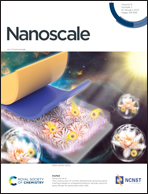Thickness-dependent excitonic properties of WSe2/FePS3 van der Waals heterostructures†
Abstract
van der Waals heterostructures (vdWHs), with their flexible combination of various two-dimensional (2D) materials, are continuously revealing new physics and functionalities. 2D magnetic materials have recently become a focus due to their fascinating electronic and spintronic properties. However, there has rarely been any investigation of the optical properties of 2D magnetic materials-based heterostructures. Herein, we construct a new WSe2/FePS3 heterostructure, in which WSe2 works as a “sensor” to visualize the thickness-dependent properties of FePS3. As characterized by photoluminescence (PL) spectra, whether under or on top of the FePS3, the PL intensity of the monolayer WSe2 is strongly quenched. The quenching effect becomes more obvious as the FePS3 thickness increases. This is because of the efficient charge transfer process occurring at the WSe2/FePS3 interface with type II band alignment, which is faster for thicker FePS3, as is evident from transient absorption measurements. The thickness-dependent charge transfer process and corresponding excitonic properties are further revealed in low-temperature photoluminescence spectra of WSe2/FePS3 heterostructures. Our results show that the thickness of 2D magnetic materials can work as an experimental tuning knob to manipulate the optical performance of conventional 2D semiconductors, endowing van der Waals heterostructures with more unexpected properties and functionalities.



 Please wait while we load your content...
Please wait while we load your content...